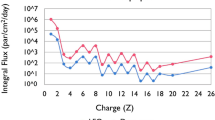Abstract
The dose reduction rates brought about by the installation of additional water shielding in a spacecraft are calculated in the paper using the particles and heavy ion transport code system PHITS, which can deal with transport of all kinds of hadrons and heavy ions with energies up to 100 GeV/n in three-dimensional phase spaces. In the PHITS simulation, an imaginary spacecraft was irradiated isotropically by cosmic rays with charges up to 28 and energies up to 100 GeV/n, and the dose reduction rates due to water shielding were evaluated for 5 types of doses: the dose equivalents obtained from the LET and linear energy spectra, the dose equivalents to skin and red bone marrow, and the effective dose equivalent. The results of the simulation indicate that the dose reduction rates differ according to the type of dose evaluated. For example, 5 g/cm2 water shielding reduces the effective dose equivalent and the LET dose equivalent by approximately 14% and 32%, respectively. Such degrees of dose reduction can be regarded to make water shielding worth the efforts required to install it.
Similar content being viewed by others
References
Wilson, J.W., Chun, S.Y., Badavi, F.F., et al., HZETRN: A Heavy Ion/Nucleon Transport Code for Space Radiations, NASA TP-3146: NASA Langley Research Center, 1991.
Sato, T., Niita, K., Iwase, H., et al., Applicability of Particle and Heavy Ion Transport Code PHITS to the Shielding Design of Spacecrafts, Radiat. Meas., 2006, vol. 41, pp. 1142–1146.
Iwase, H., Niita, K., and Nakamura, T., Development of a General-Purpose Particle and Heavy Ion Transport Monte Carlo Code, J. Nuc. Sci. Technol., 2002, vol. 39, no. 11, pp. 1142–1151.
Niita, K., Sato, T., Iwase, H., et al., Particle and Heavy Ion Transport Code System: PHITS, Radiat. Meas., 2006, vol. 41, nos. 9–10, pp. 1080–1090.
Niita, K., Chiba, S., Maruyama, T., et al., Analysis of the (N,XN’) Reactions by Quantum Molecular Dynamics Plus Statistical Decay Model, Phys. Rev., 1995, vol. C52, pp. 2620–2635.
Sato, T., Sihver, L., Iwase, H., et al., Simulations of an Accelerator-Based Shielding Experiment Using the Particle and Heavy-Ion Transport Code System PHITS, Adv. Space Res., 2005, vol. 35, no. 2, pp. 208–213.
Recommendations of the ICRP Publication 60. Annals of the ICRP, vol. 21, nos. 1–3, New York: Pergamon, 1991.
Doke, T., Hayashi, T., Kikuchi, J., et al., Measurements of LET-Distribution, Dose Equivalent and Quality Factor with the RRMD-III on the Space Shuttle Missions STS-84, -89 and -91, Radiat. Meas., 2001, vol. 33, pp. 373–387.
Badhwar, G.D., Atwell, W., Badavi, F.F., et al., Space Radiation Absorbed Dose Distribution in a Human Phantom, Radiat. Res., 2002, vol. 157, pp. 76–91.
Yasuda, H., Badhwar, G.D., Komiyama, T., and Fujitaka, K., Effective Dose Equivalent on the Ninth Shuttle-Mir Mission (STS-91), Radiat. Res., 2000, vol. 154, pp. 705–713.
Tylka, A.J. and Adams, Jr., J.H., Boberg, P.R., et al., CREME96: A Revision of the Cosmic Ray Effects on Micro-Electronics Code, IEEE Trans. Nucl. Sci., 1997, vol. 44, pp. 2150–2160.
Mitrikas, V.G., A Model of the Earth’s Radiation Belts for Estimating a Radiation Situation at the Orbit of the Mir Orbital Manned Station, Kosm. Issled., 1999, vol. 37, no. 5, pp. 548–552. [Cosmic Research, pp. 516–519].
Tomita, H., Kai, M., Kusama, T., and Ito, A., Monte Carlo Simulation of Physicochemical Processes of Liquid Water Radiolysis, Radiat. Environ. Biophys., 1997, vol. 36, pp. 105–116.
Sato, T., Watanabe, R., and Niita, K., Development of a Calculation Method for Estimating Specific Energy Distribution in Complex Radiation Fields, Radiat. Prot. Dosim., 2006, vol. 122, nos. 1–4, pp. 41–45.
Nikjoo, H., Khvostunov, I.K., and Cucinotta, F.A., The Response of Tissue-Equivalent Proportional Counters to Heavy Ions, Radiat. Res., 2002, vol. 157, pp. 435–445.
Guetersloh, S.B., Borak, T.B., Taddei, P.J., et al., The Response of a Spherical Tissue-Equivalent Proportional Counter to Different Ions Having Similar Linear Energy Transfer, Radiat. Res., 2004, vol. 161, pp. 64–71.
Sato, T., Tsuda, S., Sakamoto, Y., et al., Analysis of Dose-LET Distribution in the Human Body Irradiated by High Energy Hadrons, Radiat. Prot. Dosim., 2003, vol. 106, pp. 145–153.
Sato, T., Tsuda, S., Sakamoto, Y., et al., Conversion Coefficients from Fluence to Effective Dose for Heavy Ions with Energies up to 3 GeV/A, Radiat. Prot. Dosim., 2003, vol. 106, pp. 137–144.
Badhwar, G.D. and Cucinotta, F.A., A Comparison of Depth Dependence of Dose and Linear Energy Transfer Spectra in Aluminum and Polyethylene, Radiat. Res., 2000, vol. 153, pp. 1–8.
Badhwar, G.D. and Cucinotta, F.A., Depth Dependence of Absorbed Dose, Dose Equivalent and Linear Energy Transfer Spectra of Galactic and Trapped Particles in Polyethylene and Comparison with Calculations of Models, Radiat. Res., 1998, vol. 149, pp. 209–218.
Shurshakov, V.A., Petrov, V.M., Ivanov, Yu.V., et al., Solar Particle Events Observed on Mir Station, Radiat. Meas., 1999, vol. 30, pp. 317–325.
Author information
Authors and Affiliations
Corresponding author
Additional information
Original Russian Text © T. Sato, K. Niita, V.A. Shurshakov, E.N. Yarmanova, I.V. Nikolaev, H. Iwase, L. Sihver, D. Mancusi, A. Endo, N. Matsuda, Y. Iwamoto, H. Nakashima, Y. Sakamoto, H. Yasuda, M. Takada, T. Nakamura, 2011, published in Kosmicheskie Issledovaniya, 2011, Vol. 49, No. 4, pp. 329–334.
Rights and permissions
About this article
Cite this article
Sato, T., Niita, K., Shurshakov, V.A. et al. Evaluation of dose rate reduction in a spacecraft compartment due to additional water shield. Cosmic Res 49, 319–324 (2011). https://doi.org/10.1134/S0010952511040083
Received:
Revised:
Published:
Issue Date:
DOI: https://doi.org/10.1134/S0010952511040083




